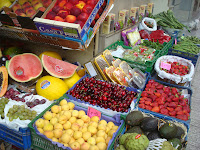 |
| Many fruit and veggie markets along the way |
I am a 65
year old woman and along with my husband walked the Camino de Santiago in
May/June 2012. I have been vegan for over 15 years and before leaving for Spain
I often checked on various websites to find information about being vegan on
the Camino…but to no avail. It is for this reason that I decided to keep notes
of what I ate during our trip to remind myself how it was possible, though difficult.
Because I have a minor problem with wheat and other gluten products, I was also
very conscious of the details of how I remained this way for 99% of my Camino.
For me, the
desire to be vegan stems from three different “routes”. First is for the benefit
to our planet, secondly are the health benefits for me and thirdly for the
lives of animals. I practice yoga regularly and believe in “ahimsa” which means
“do no harm”. This fits with my spiritual practice and is important for me.
Also important for me is to let others live as they wish so my intention here
is to provide information to those who are interested in traveling the Camino
this way and not to profess that this is the “only” way. You see, one of the
main lessons that we both learned on the Camino is that it represents life
itself and that there is no “one” way to do this. Each of us needs to find ones
own special “way” and though planning is important, letting go is also
important. Trying to control oneself or others at all times is impossible.
Spain, in
general, is a meat and fish eating country and for sure this was true in the
north. Many people did not have any concept at all of what the words vegetarian
and vegan mean (a bit like 15 years ago in the USA). I realized early on that I
needed to ask many questions in restaurants before choosing items. My level of
Spanish was sufficient for understanding all food labels and this would have
been difficult without the language. One interesting note about buying
vegetables in stores…many would not allow us to choose and bag our own
vegetables. One has to wait for a store employee to choose them and weigh and
bag them. Their reason is that they do not like the food to be handled by many
people to prevent bruising of the fruits/vegetables. They also want to reduce
the transmission of germs. Many of the stores had beautiful displays.
Here are the
basics of our eating on the Camino:
 |
| Padron (peppers with salt) ... we loved these! |
- · Most days I started off eating fruit and/or 1 or 2 rice or corn cakes for breakfast with a cup of tea. The most common activity for most pilgrims is to stop for a “café con leche” after 1-2 hours of walking and I would usually have a cup of tea. For those vegans who eat bread there was usually bread or toast available in most of the “bars” where one eats and or drinks all day. Juice, often fresh, was always available.
- · Lunch would usually include nuts, corncakes and fruit. There were a few times during the early days on the camino when there was no option at all and so my “off vegan” moments included what the Spanish call a Spanish tortilla, torta or omelette which consisted of mostly potato, onion and some egg. For me I felt that the protein was important when I did not have any nuts or beans. After several days on the camino I discovered stores that had both nuts and beans – usually lentils and garbanzos and here and there red or other beans. Some might cringe at the following…I put my beans or lentils in little baggies and ate them cold along the way, with my spork. I actually liked this snack, sometime scooped with some endive or lettuce.
- · Snacks were nuts, fruit, veggies, beans, corn or rice cakes (bread for Richard), potato chips, occasional dark chocolate (sugar free for me).
- · Dinner for most folks was a “Pilgrim’s Meal” – 3 courses including wine or water. These meals always contained fish or meat and for us was not a favorite as we also do not drink alcohol. We did, however, manage and usually had a salad (reminding them to hold the tuna and egg), a vegetable dish (many times was white asparagus or menestre de verduras -vegetable stew). Pasta with tomato sauce or some vegetables was often an option for the pilgrim meals and I did it eat it on a very rare occasion, though it does not sit well in my stomach. In the several cities including Pamplona, Burgos, Leon and Santiago we found vegetarian restaurants and a great vegan restaurant in Burgos. We found vegetarian paella in many restaurants and this was a delicious alternative.
- However, many nights I concocted our own meals in the many albergues that have kitchens. This usually involved going shopping in the little villages for some vegetables and beans. Using either a stove or microwave I was able to cook delicious meals. There were often some spices or condiments in the albergues that could be used by pilgrims. From time to time I found microwaveable rice in small packets that I served with a hot meal and we often had salads to go with the meals. Richard would enjoy the many breads of Spain which were available in every town.
